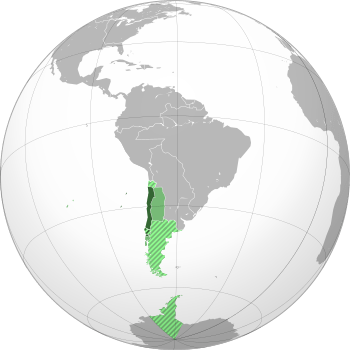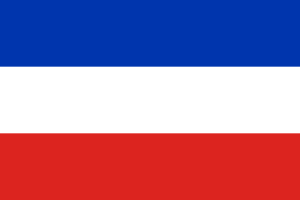Patria Nueva facts for kids
Quick facts for kids
State of Chile
Estado de Chile
Estado Chileno Patria Nueva |
|||||||||
|---|---|---|---|---|---|---|---|---|---|
| 1817–1826 | |||||||||
|
Anthem: (1819–1826)
Canción Nacional Chilena |
|||||||||

Effective territory and claims based on the uti possidetis of 1810.
|
|||||||||
| Capital | Santiago de Chile | ||||||||
| Common languages | Spanish (official) Indigenous languages (Quechuan languages, Aymara, Mapudungun, Kawésqar, Yaghan) |
||||||||
| Government | Dictatorship | ||||||||
| Supreme Director | |||||||||
|
• 1817-1823
|
Bernardo O'Higgins | ||||||||
|
• 1823-1826
|
Ramón Freire | ||||||||
| Historical era | Decolonization of the Americas | ||||||||
| 12 February 1817 | |||||||||
| 12 February 1818 | |||||||||
| 5 April 1818 | |||||||||
|
• Provisional Constitution
|
23 October 1818 | ||||||||
|
• Constitution
|
8 August 1822 | ||||||||
|
• Disestablished
|
28 January 1826 | ||||||||
| Population | |||||||||
|
• 1818
|
850,000 | ||||||||
|
|||||||||
Patria Nueva (which means New Fatherland) was an important time in the history of Chile. It started on February 12, 1817, after the Ejército de los Andes won the Battle of Chacabuco. This period ended in 1823 when Bernardo O'Higgins stepped down as the leader, called the Supreme Director. During Patria Nueva, Chile worked hard to become truly independent from Spain.
Contents
Bernardo O'Higgins's Government
Bernardo O'Higgins was a key leader during Chile's fight for independence. He became the Supreme Director of Chile and made many important decisions to help the new country.
First Steps as Supreme Director
Soon after becoming the Supreme Director of Chile, O'Higgins took action. He sent a ship, the Aguila, to rescue Chilean patriots. These patriots were stuck on the Juan Fernández Islands. O'Higgins also created an army to fight against the Spanish forces. These Spanish forces were hiding in the port of Talcahuano. He also fought against groups called montoneras. These groups included people who were against independence, native groups, and bandits. They were active near the Bio-Bio River.
O'Higgins set up a special court called the Vindication Tribunal. This court helped patriots get back their belongings. These items had been taken by the Spanish during the Reconquest. He also ordered some priests to leave the country. These priests wanted Chile to remain loyal to the Spanish king.
The Surprise Attack at Cancha Rayada
The independent Chilean forces were waiting in Talca for the Spanish royalist army. But the royalists chose a different route. This caught San Martin and O'Higgins by surprise.
In Santiago, people became very scared. They heard about the defeat of the Chilean army. Many people in Santiago started to leave again. They went into exile in Mendoza. Rumors spread quickly that O'Higgins and San Martin had died.
During this scary time, on March 23, Manuel Rodríguez spoke up. He famously shouted, "We still have our homeland, citizens!" He then declared himself the new Supreme Director. Rodríguez also created a special group of soldiers called the Húsares de la Muerte. Many people who supported the Carrera family joined this group. They promised to die rather than see Chile controlled by Spain again. When he heard this, O'Higgins returned to Santiago. He traveled against his doctor's advice. San Martin came with him. Both leaders were welcomed with cannon shots on the morning of March 24.
Making Independence Stronger
Even after declaring independence, Chile and Argentina faced challenges. Spanish royalist forces were still strong in Peru. So, San Martín continued his plan to invade Peru. O'Higgins supported him with extra help. In 1820, the Chilean government organized the Freedom Expedition of Peru. This expedition was led by General José de San Martín and Lord Thomas Cochrane. It was a major force in the Peruvian War of Independence. In 1822, San Martin left the campaign. He resigned as Protector of Peru. Simon Bolivar took his place. Bolivar was supported by the Colombian government. He continued the fight for Peru's independence.
Lord Cochrane delivered a major blow to the royalists in Chile. In 1820, he captured the Valdivian Fort System. This was the strongest fortified place in South America at that time. Cochrane succeeded in the Capture of Valdivia by launching a surprise attack from land. He then sent a small group of soldiers led by Jorge Beauchef. Their mission was to chase the royalist army. This army was fleeing from Valdivia to Chiloe. Along the way, they conquered cities south of Valdivia. These included Me Río Bueno and Osorno.
After capturing Valdivia, Lord Cochrane left Colonel Jorge Beauchef in charge. Beauchef became the commander and governor of Valdivia. On March 6, 1820, Colonel Beauchef defeated the royalists. This happened during the battle of El Toro. From Valdivia, Cochrane went to Chiloe. He tried a ground attack on Ancud but had to retreat. After the battle of El Toro, Beauchef began to strengthen his army's presence. This was in the southern Chilean region, but it did not include Chiloé.
See also
 In Spanish: Patria Nueva para niños
In Spanish: Patria Nueva para niños




